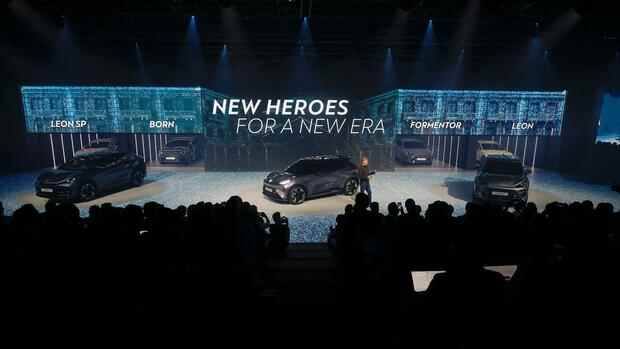Dusseldorf The note from Volkswagen CEO Herbert Diess could hardly have been clearer: “It’s high time,” he recently wrote about Seat on Linkedin. The Spanish subsidiary must become profitable “as soon as possible”.
Seat is increasingly worrying VW headquarters. The company from Catalonia is the only car subsidiary to be in the red in 2020 and 2021, two consecutive years. The first quarter of 2022 did not go well either: five million euros in operating income represent a return of 0.2 percent.
Seat boss Wayne Griffiths replied to the CEO in distant Wolfsburg: “I accept the challenge”. The young, sporty brand Cupra, which Seat launched as an additional offer four years ago, is to be the rescuer in an emergency. Cupra models are positioned above Volkswagen and can be sold at higher prices. With the sports brand, the Seat losses should disappear and make the Spanish subsidiary a profitable car manufacturer.
Wayne Griffiths now wants to strengthen Cupra with a product offensive. On Tuesday evening, the Spanish VW subsidiary presented three new models near Barcelona, not far from the company headquarters. “Griffiths is fleeing to the front,” said Wolfsburg corporate circles. The losses were viewed more and more critically at headquarters. Seat have built a larger apparatus with corresponding costs. However, the sales figures are too low.
Top jobs of the day
Find the best jobs now and
be notified by email.
In contrast to the Seat brand, which will foreseeably focus on models with combustion engines, Cupra should not only shine with a sporty image, but also with an electric drive. The models presented on Tuesday, which will be launched one after the other until 2025, meet this condition.
Cupra sales are expected to double in 2022
“Urban Rebel” and “Tavascan” are purely electric models, the “Terramar” is a plug-in hybrid. The “Terramar”, an SUV, will probably be the last new Cupra model in which an internal combustion engine will be installed. After that, the second young Seat brand should only have purely electric cars.
Last year, the Spanish Volkswagen subsidiary produced a good 80,000 Cupra vehicles. Wayne Griffiths did not name a specific year, but “in the medium term” 500,000 Cupra vehicles should be sold annually. With that, Cupra would surpass the Seat brand. Griffiths also wants to sell Cupra in new countries. An example of this is Australia.
The upswing of Cupra should also be evident from economic figures in the near future. In 2021, the second Seat brand had achieved sales of 2.2 billion euros. In 2022, sales – supported by new models – are expected to roughly double. Griffiths did not provide any information on return planning.
Seat boss Griffiths enthusiastically presented the three new electric models: “I’m looking forward to the beginning of a new chapter. The future is electric, the future is Cupra,” he said. The young brand from Spain combines the modern electric drive with “emotional mobility for the next generation of car lovers”.
The future entry-level model “Urban Rebel”, which is to be produced and sold from 2025, plays a special role. The automotive industry has so far lacked inexpensive electric models for less than 25,000 euros. These are cars in the format of a Volkswagen Polo or an Opel Corsa. Tesla had announced such an all-electric entry-level model for 2023; Earlier this year, Tesla boss Elon Musk postponed the vehicle project indefinitely.
Seat wants to establish small electric cars in the auto industry
With the “Urban Rebel” from Spain, the Volkswagen Group now wants to do pioneering work for the automotive industry. The electric entry-level model will not only be available from the Cupra brand, but probably as an ID.2 from Volkswagen and also as a Skoda variant. In the second half of the current decade, more than 500,000 copies of the small electric car in all brand variations are likely to be manufactured annually. Vehicle development is in the hands of Seat.
>>> Read here: Why the electric offensive at VW is faltering due to major software problems
The Volkswagen Group wants to invest around seven billion euros in the coming years to start electric production in Spain. The main Seat plant in Martorell near Barcelona and the VW Polo factory in Pamplona will be converted for this purpose.
In addition, Volkswagen wants to build a new factory for battery cells not far from Valencia. Batteries based on iron phosphate are to be produced there. They are significantly cheaper than the lithium-ion batteries often used up to now and make a small electric car possible for less than 25,000 euros.
Seat boss Griffiths was confident that this new class of electric small cars will prevail in the car business. “We will prove that electric cars don’t have to be boring,” he said. This applies in particular to the newly planned Cupra entry-level model.
Volkswagen CEO Herbert Diess had previously defended the prominent position of the new Spanish brand. “Cupra will not replace Seat. But Cupra will help Seat to become much more profitable,” emphasized Diess. The Seat brand has a product portfolio that has never before existed with such strength and breadth. This could lead to success in the years to come.
In Spain, however, the emphasis on the Cupra brand was not accepted without objection. Criticism came from the unions and the Seat works council. The Seat brand faces an uncertain future because there are no electric cars from the traditional Spanish brand. The brand is likely to be phased out at the beginning of the next decade because combustion models will then no longer be produced.
More: The Spanish Volkswagen brand Seat is threatened with a slow end
